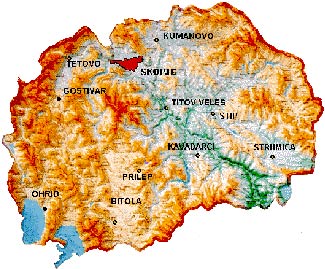
Map of Republic of Macedonia
The Republic of Macedonia is situated on the Balkan Peninsula, on the crossroads of the main routes which have for millenniums connected the three continents: Europe, Asia and Africa. Its territory stretches over 25.713 km2. It borders on Greece southwards, on the Republic of Serbia northwards, on Bulgaria eastwards and on Albania westwards.
Macedonia has diverse climatic conditions. In the valleys alongside the Vardar and the Strumica rivers, the climate is intermittent Mediterranean; the northern oval valleys and the hill-encircled basins are characterized by continental, or temperate continental weather, whereas it changes into typical mountainous in the high mountain regions. Because of the relief differences, the annual rainfall is variable in various Macedonian areas. The lack of rainwater in the locations of Demir Kapija and Ovce Pole result in frequent droughts, the consequences of which are being alleviated by the construction of irrigation systems. The total population inhabiting the Republic of Macedonia is approximately 2.100.000, 67 per cent of which are Macedonians, around 21 per cent Albanians, around 5 per cent Turks, and the remaining citizens belong to other different nationalities.
The population is concentrated in 29 urbanized and, many more, rural areas. The capital of Macedonia is ‘ the city of Skopje, with 563.301 residents. Some of the other bigger cities are: Bitola, Prilep, Stip, Ohrid, Kumanovo, Veles, Tetovo. Skopje is an industrial, administrative, university and cultural centre. After the disastrous earthquake in 1963, the new city has grown into a European architectural and urban entity. Nevertheless, Skopje has preserved an interesting union of Western and Oriental culture. Numerous monuments from the past coexist with newly built ones.
The official language is Macedonian, written in Cyrillic script. Except for the Macedonian language and the Gyrillic alphabet, the languages and alphabets of the nationalities are used officially, in a legally regulated manner, in the municipalities where a particular nationality is represented by a considerable number of inhabitants.
Macedonian citizens .are granted free religious beliefs and activities: they can openly and publicly, individually or in association with others, express their religious faith. The Macedonian Orthodox Church, as well as the other religious communities and groups, are separated from the state and are equal in terms of the legislation.
Its geographical position, and, in particular the Macedonian stormy history, have made it possible for the western and eastern culture, traditions, folklore and customs to intertwine in this relatively small area, and to be supplemented by contemporary European multi cultural values at the present time. The historical experience acquired through the ever lasting struggle for freedom and justice, has enabled these people to develop a great social ability to adapt themselves to present and future changes that are to take place in the course of social progress. Macedonians have always been friendly, persistent in their democratic ambitions, hard working and ready for any land of cooperation that leads to economically productive results.

Virtual Macedonia
Republic of Macedonia Home Page
Here at Virtual Macedonia, we love everything about our country, Republic of Macedonia. We focus on topics relating to travel to Macedonia, Macedonian history, Macedonian Language, Macedonian Culture. Our goal is to help people learn more about the "Jewel of the Balkans- Macedonia" - See more at our About Us page.
Leave a comment || Signup for email || Facebook |
History || Culture || Travel || Politics














